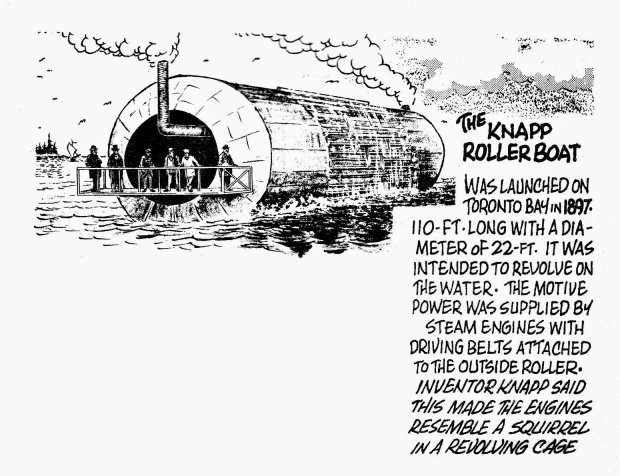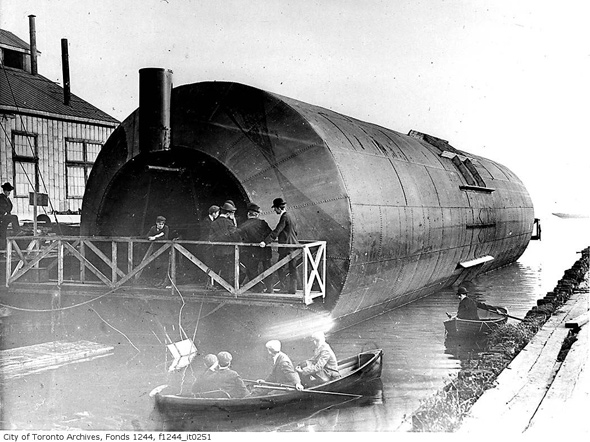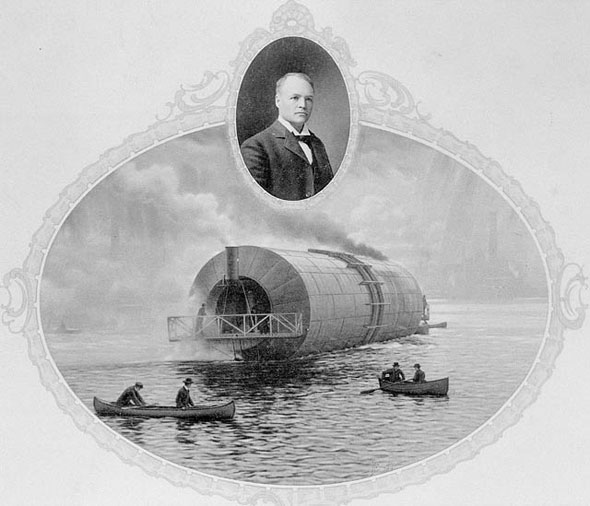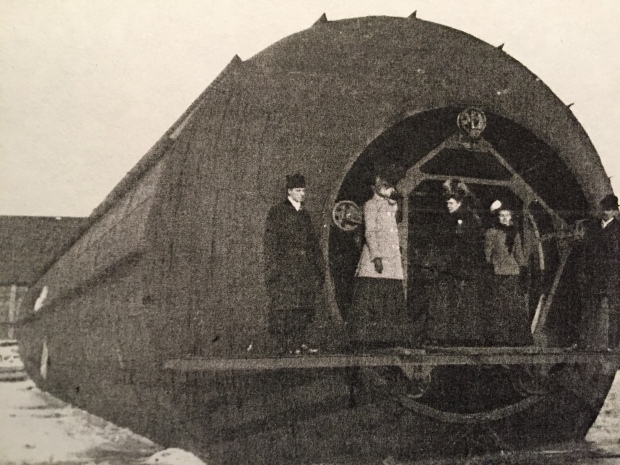Concealed beneath Canada’s largest city lies an iron apparatus designed in Prescott, Ontario from the Victorian Age that resembles an invention from the pages of a Jules Verne novel. A perfect example of the steam punk aesthetic, this 110ft. ironclad cylindrical vessel remains buried under the Gardiner Expressway, quietly resting below the traffic of thousands of commuters. Its remarkable story is one of innovation, passion and ill-fated decisions. Join me now as we uncover the whereabouts of this lost tubular dream…
PROLOGUE

Prescott in the late 1800’s was bustling industrial town.
The small town of Prescott sits 45 minutes south of Ottawa and during the late 19th century it was a booming community of industry and innovation, a town that was the inception for J.P. Wiser’s Whisky, Ottawa’s first railway, the Prescott & Bytown Railway, and it even had Bell telephone service far sooner than any other town. The terminus for the Great Lakes Shipping industry, it also was home to a Labatt’s Brewery. It comes as no surprise that from its dusty streets would appear another creative force, an ironclad machine so imaginative, so unique and so bold that it would garner the attention of the world stage in 1897.

Queen Victoria hated traveling by ship due to sea sickness. (Image:Wikipedia)
At the time Queen Victoria was the reigning monarch, but she never visited her colonies since she hated traveling by sea, as it made her sea-sick. In 1860 she sent her son, Albert Edward to Ottawa and on a North American tour in her place. This led one Prescott resident to design a ship impervious to the travel and motions that caused sea-sickness on the open sea. His name was Frederick Augustus Knapp, a lawyer turned inventor, and he designed what was probably the most bizarre, ambitious and unbelievable ship ever to be made.

Ripley’s cartoon depicting a strange and unique vessel that began my quest to find it.
I became fascinated with this iron clad marvel when I saw an old Ripley’s Believe-It-Or-Not illustration featuring Knapp’s craft, and always wondered what happened to it. I researched its history and it turns out the Iron Tubeship was designed and operated in Prescott, just a short drive from my home. As I dug deeper into its voyages through time I learned it now lies most likely buried under the Gardiner Expressway in downtown Toronto. But before we get to that point, how did such a ship get there in the first place, and why?
PRELUDE TO THE IRON DREAM
Fred Knapp had a vision for a giant tube ship 800 feet long that would glide over ocean waves at 60mph, undisturbed by the rolling sea. His idea was soon put to paper as he drew out plans for a scaled down version of his iron dream, imagined on his many trips across the Atlantic aboard steamship liners of the day. In an interview with the Prescott Telegraph in 1897, Knapp revealed he spent most of those voyages within the engine rooms of the ships he was aboard, studying the mecahnics of how to overcome the resistance of water and waves. He realized that a ship must not fight them, but join them, and ROLL over the waves. Working at a law firm in Montreal, Knapp soon moved back to his hometown of Prescott where he set up a law practice and purchased a home in a stone triplex on Dibble Street.

Knapp’s residence still exists in Prescott where he designed the Iron Tube Ship. (Image: Google Streetview)
I journeyed to Prescott to see if the original Knapp residence where he drew up the idea and plans for his colossal Victorian Tube ship still existed, and indeed it does at 272 Dibble St, a modest end unit of a larger 19th century stone triplex building. No plaque or indicator is there to tell of what was designed behind its walls, but this is where Knapp created what would become a most fascinating piece of nautical history.
Soon after drawing up plans for his mighty steam tube, Knapp presented the concept to Polson Iron Works in Toronto, and had built a working scale model 9 feet in length. The original drawings for the Roller Tube Ship are stored in the since closed Maritime Museum of the Great Lakes in Kingston, Ont., of which I unfortunately can not get access to at this time.
Knapp soon organized a joint stock company called “The Knapp Ocean Navigation Company” and raised funds from investors in Montreal, Quebec City, the UK and Toronto. His proposal to Polson Iron Works in Toronto was accepted and they were contracted to build the vessel as a working steam powered prototype at a cost of $125,000 (in 1890s dollars).

Knapp’s tube ship gained the attention of Scientific American magazine in 1898 with his unique design.
After some trials and tests, a full scale, 110-foot prototype was ready for launch in Toronto’s harbour in June of 1899. With Knapp aboard manning the helm, the innovative new ship was to travel from Toronto to Prescott on its maiden voyage.


Photo of the Roller Boat underway in 1898.
Perhaps because it was never officially christened or named, the poor ship was to be doomed. On June 9th it ran aground in Bowmanville, and it took a month for a tugboat to arrive and tow it all the way to Prescott where it was holed up and underwent modifications until the ship was ready for another sea trial in 1901.

Knapp’s Roller Boat steaming along, his portrait above.
Seeming to be a glutton for punishment, Knapp decided to test his newly modified ship on a cold February day, with a strong north wind that hampered its planned voyage across the St. Lawrence to Ogdensburg, NY.

Prescott citizens slide over the ice to board Knapp’s latest modded ship. (Image: Morris History Of Prescott)

Dressed for the February cold, the passengers await Knapp to take them across the St. Lawrence River to Ogdensburg, NY (Image: Morris History Of Prescott)
The strong winds were no match for the very hard-to-steer giant tube ship, and Knapp and his ship ran aground on a shoal of mud off Ogdensburg, where it soon became trapped in ice and snow. A rescue team was sent out in rowboats to retrieve the passengers and Knapp, who were suffering from exposure to the cold. The iron tube was towed back to Prescott where it remained for the winter.

Knapp decided to now modify the shape of his shape into that of a giant cigar, with conical ends, and a new engine, but it had to towed to Montreal for that work. After an arduous tow and retrofit in Montreal going through the myriad of canal locks, the roller boat was then towed back to Toronto across Lake Ontario, around Prince Edward County and into the docks of Polson Iron Works once again. There the ship sat, Knapp now out of money and investor interest, its forlorn hull left to languish in the waters off Toronto. The orphaned vessel that no one wanted broke free of its moorings and hit another ship causing damage to both ships. The now rusting hulk was sold for scrap metal to pay for the damages. As World War One began, it was said the tubular disaster was scavenged for its metal for the war effort, picked apart like a carcass under the beaks of vultures.

Showing its new cigar shape, but badly deteriorating due to salvaging its parts, the un-named Roller Ship lies in the waters off Toronto.
Left deteriorating in the shallow waters, legend says the ill-fated ship was buried under landfill when in 1927 the Toronto shoreline was expanded, its whereabouts unknown.

Completely forlorn, what’s left of the Iron Steam Dream lies in the mud awaiting to be filled over when the Toronto shoreline was expanded overtop of it.

Knapp returned to Prescott, continued his law practice and dabbled in other inventions, but nothing similar to his grandiose Roller Boat. He died in 1942, buried at the Blue Church cemetery outside of Prescott, joining his beloved ship below ground for eternity.

Knapp’s unassuming gravestone in the Blue Church cemetery near Prescott.
FINDING THE LOST SHIP

It is remarkable how the internet can provide a trail of bread crumbs that lead to a successful quest for information. Searching records of recent archeological assessments of downtown Toronto for any mention of “Polson Iron Works” where Knapp’s boat had its final days, it was revealed that a report called “Toronto Transit Commission Environmental Assessments for Transit Projects in the Eastern Waterfront Assignment 4: Stage 1 Archaeological Resource Assessment of theEast Bayfront Transit Precinct City of Toronto, Ontario, Prepared for McCormick Rankin Corporation in 2009″ reveals the EXACT location of Knapp’s Victorian Steam Dream.

Bingo!
Page 21 of the report states “The remains of this unusual ship lie buried 356 feet (108.5m) south of the Frederick Street slip and 140 feet (42.7m) west of the Polson Iron Works dock (wharfs 35 and 36)as they existed in 1923. Today, this location corresponds to the area between Lakeshore Boulevard andthe Gardiner Expressway, between Richardson and Lower Sherbourne Streets and north of the property currently known as 215 Lakeshore Boulevard East (Figure A 13). Placement of the vessel under these roads is generally consistent with that proposed earlier by Stinson and Moir (1991:112)”

Apparently, according to the archeological assessment, in 1923 soundings were done by the Toronto Harbour Commission that labeled a “wrecked roller boat” and that no dredging was to be done here. This means the remains of the tubular ship were likely covered over by fill as the land was extended, and it remains buried there to this day.
Where that spot exactly rests is the subject of the following information.
THE LOCATION

The assessment has a map pinpointing the exact location of the lost 1897 ironclad tube ship. (image: Archeological Surveys Inc.)
Using modern Google Maps with the corresponding Archeological Survey plans, we can superimpose the two together to reveal the exact location of the lost ship. Using Photoshop to “ghost” the two together, we can see that the ship lies buried perpendicular to Lake Shore Blvd, and partially underneath the Gardiner Expressway. Located behind what is now a FedEx depot, the 110 ft ship may lie beneath tens of feet of earth and service lines, its state of decay unknown.





Beneath the street at this location in view of the CN tower lies what is left of Knapp’s Great Steam Dream.
Whether this unusual chapter in maritime engineering warrants a proper archeological excavation to find a 19th century iron clad tube ship is a matter left to city officials, but next time you pass behind that FedEx depot on Lake Shore Blvd East, remember Knapp’s iron steam dream that lies below.
Andrew King, January 2018
SOURCES
Morrises’ History Of Prescott, John A.H.Morris, 2000.
As usual, thank you for presenting such an impeccably researched topic, not to mention an absolutely fascinating story !! I always look forward to reading your entries. Keep up the great work !
A simple ditto to the above comment, Andrew. The story of this list iron ship was, well… “rivetting”.
I worked at the 215 Lake Shore FedEx depot from its May 1999 opening to the March 2017 closure. From time to time there would be some speculation about the wreck. We learned the contractor that built the depot had to dig around a sizeable metal tangle obstructing the SW corner of the drainage loop. This would be close to the Richardson Street gate access to the property. Just meters further south and west of the wreck site. Since they were infilling in a southerly direction in 1927 and cut the roller boat up we wondered if this could be a part of it?
Amazing! Most likely that was it. I wish they’d dig it up!
F. J French’s home is located on County Road 2 in Augusta Township just west of Prescott. It is no longer occupied and in very bad condition. There are plans to put a subdivision called Augusta Landing at that site. The land records show French owning this property, but no evidence that he ever owned the Dibble Street property. Your article is interesting and does contain lots of good information.